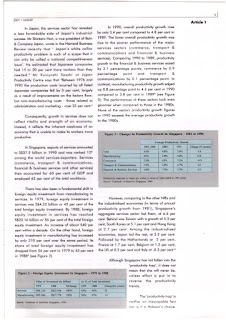The 'Productivity Trap' in Services
The evolution of a developed service-centred economy has significant implications on a country economic growth, investment and capital formation, employment and productivity. Services tend to be more labour intensive and use less capital equipment than manufacturing. Productivity growth tends to be slower in services than in manufacturing - a 'productivity trap' of a developed service-centred economy.
The 'productivity trap' is neither an inescapable fact nor is it a Hobson's choice. The choice does not lie with the government, it lies with the organisations themselves. It is the task of every member in the organisation to help raise the productivity and quality of the services they provide.
Understanding Productivity and Quality in Services
Productivity and quality in services have many differences compared with their manufacturing siblings, which produces physical goods. Although these differences are varied and widely recognised, to the customers in buying a product or service, their main goals remain the same, that is, to maximise their utility or satisfaction. Productivity and quality in services is all about customer satisfaction.
The paradigm to manage productivity and quality in services can be conceptualised as an ongoing process of integrating the dynamic relationship of customer, organisation and environment to achieve continuous customer satisfaction.









No comments:
Post a Comment